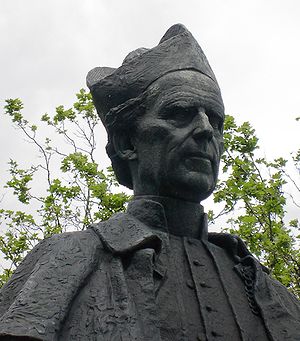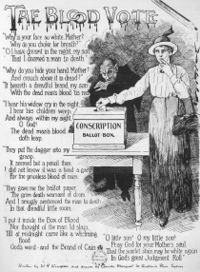- World War I conscription in Australia
-
Conscription is the duty and law that may be applied to people of the public. This insures that if the time calls certain individuals or groups may join military forces or the like.
Contents
The Conscription Debate
On 1 January 1911, the Commonwealth Defence Act 1911 (Cth) was passed. This meant that that all males aged 12 to 26 years of age would receive compulsory military training. This, however, did not force them to participate in the war itself when the time came. The actual conscription debate began in 1916 when Prime Minister Billy Hughes visited the war front himself. On his return to Australia, he then voiced his thoughts of conscription as his view was that Australia needed more soldiers. Due to this during 1916 and 1917 a referendum was held to discuss the matters and hand it over to the public. Although three states voted "yes" and three "no", the majority of the population was against the amendment of the original law. This was duly rejected, if only by a small margin of 72 476 votes. As a result, recruiting was stronger than ever and intensified campaigns were popping up in every city. Some of the arguments against conscription were that enough lives had been lost and that farmers need more men to work the land for food. There were two things needed for the war more than anything: men and money.
The role of women
One the primary roles of women in conscription was in the recruiting and campaigns. They would often be on posters or in the posts. They would be positioned during this time as vulnerable, perhaps with children, and be made out to be weak, and therefore in need of protection. One quote from one photos even recounts, 'Any right—minded woman would rather be a mother or sister of a dead hero than of a living shirker.' Women during World War I were also a huge pacifist movement often going through great deals to hold out for peace. Once again, they portrayed themselves as wives, sisters, sweethearts or mothers. Women often did less dangerous jobs that needed to be done for instance visiting and healing wounded soldiers. Often, they would hold small or confectionery sales, such as sold buttons on button days, rattled collection boxes on collection days, organised fetes, baked cakes, put together 'comfort parcels' and, above all they knitted. Quite a few women looked to take a greater part in the more war related activities. This included cooking, stretcher bearing, drivers, interpreters and munitions workers. However the government did not allow it.
The referendum process
Prime Minister Billy Hughes hosted a referendum on 28 October 1916. His campaign for conscription was supported by the major newspaper companies and other media. It was also supported by most of the Liberal Party of Australia including the Liberal state premiers, by the major Protestant churches and the Universal Service League, which had many prominent Australians as members. The result was that there were 1,087,557 in favour and 1,160,033. The referendum failed. An effect of this was Prime Minister Billy Hughes losing his seat in the Australian Labor Party.
Daniel Mannix
 Statue of Daniel Mannix outside St Patrick's Cathedral, Melbourne
Statue of Daniel Mannix outside St Patrick's Cathedral, Melbourne
Daniel Patrick Mannix (4 March 1864 – 2 November 1963), Irish-born Australian Catholic clergyman. This cardinal was one of Australia's biggest influences in the 20th century. He was extremely passionate about what he thought. During World War I he stated that it was all "just a sordid trade war", for this he was denounced and even categorised as a traitor. He was one of the people who campaigned against Prime Minister Hughes when his referendum for conscription failed. He went through with his argument religiously and when the Labor Party split he participated in supporting the Catholic side of the anti-conscription debate. Through this he encouraged the political endeavours of James Scullin, Frank Brennan, Joseph Lyons and, later, Arthur Calwell. Mannix was a very moral man and keen for the laws of the church and the power they held.
William Hughes
Hughes was the Prime Minister in seat at the time of World War I 1916. In 1917 he visited the war front. Hughes was a strong supporter of establishing Australia as a strong and significant country and therefore thought that Australia's participation in World War I was mandatory. In between the dates of July and August 1916, there was a loss of 28,000 men and Generals Birdwood and White of the Australian Imperial Forces impressed upon Hughes that conscription was needed for Australia to continue impacting the war sufficiently. At this time, Hughes was the leader of the Labor Party. When he proposed the idea for conscription two thirds of his party disagreed with his views. Hughes, however, knew that he did not need to create a new law but could just amend the old one to include conscription. As a result, on 28 October 1916, a referendum was held to decide whether the community of Australia supported conscription. The vote was rejected and Hughes was sacked from his seat in the Labor Party. He moved to the Liberal Party afterward but never succeeded in introducing conscription in Australia.
References
- Encyclopædia Britannica- Macropedia Volume 21
- Encyclopædia Britannica- Macropedia Volume 12
See also
Categories:
Wikimedia Foundation. 2010.

